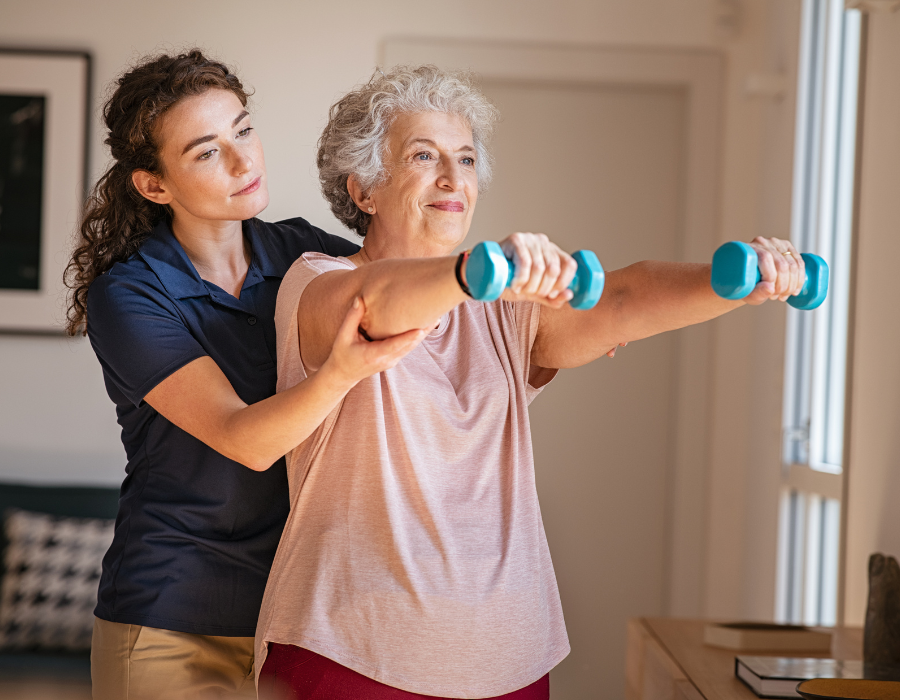For individuals looking to recover from an illness or injury, there are a variety of rehabilitation options available. Two of the more popular options are in-patient rehabilitation facilities and home and community rehabilitation.
Inpatient rehabilitation generally requires an individual to stay at a specialized facility for the duration of their treatment. Here, they will have access to resources such as medical staff, special equipment, and group activities that can help them progress and reach their physical or psychological goals.
In-home rehabilitation is also a valid option for many. This type of care allows individuals to receive therapies from the comfort of their own homes with personalized plans designed to meet their specific needs while still maintaining access to various resources such as doctors and support meetings if needed.
A home and community rehabilitation program gives individuals access to valuable resources they need during their recovery journey such as occupational therapy, physical therapy, speech therapy and recreational therapy, as well as life-skills navigation and case management.
While both have their benefits, in-home and community-based rehabilitation typically provides greater convenience, comfort, motivation and peace of mind for the patient and their family.
What is In-Home Rehabilitation?
Home rehabilitation focuses on helping individuals attain the skills necessary to live as independently as possible at home. This could include therapeutic exercises designed to improve mobility, strengthening muscles, improving balance or coordination, education about how to use assistive devices like walkers or wheelchairs, and practice using those devices in different environments.
A therapist may also provide advice about safety measures for the home such as installing grab bars in the bathroom or recommending modifications that can be made to accommodate a wheelchair.
Additionally, if needed, a therapist can provide guidance on how to manage medications, establish healthy routines and habits, and prepare meals. In short, home rehabilitation is all about providing clients with the tools they need to care for themselves at home while maintaining functional independence.
What is Community Rehabilitation?
Community rehabilitation provides individuals with the opportunity to engage in meaningful activities outside of the home setting. This could involve learning how to use public transportation, developing communication skills so one can interact more confidently in social situations, or building confidence by participating in recreational activities such as sports or hobbies.
Community rehabilitation programs also involve teaching individuals how to navigate their community safely by learning street signs and traffic patterns or finding different resources available within their communities such as medical facilities or food pantries.
The goal of community rehab is for clients to become fully integrated into their communities so they can access necessary services without assistance from others.
Home and community rehabilitation services are supportive tools which allow the continuation of care within a familiar environment.
The main purpose of these services is to improve the quality of life of patients, reduce the burden of caregivers, and to avoid the occurrence of new disabilities by assisting the patient in day-to-day activities.
Dignity, Independence and Maximum Comfort
Familiar surroundings of home can help the participant feel more comfortable and relaxed. Having access to your own personal possessions, like your favorite chair or blanket, offers comfort and can actually speed up the rehabilitation process.
Additionally, since rehabilitation takes place at the patient’s home, they are able to stay close with family members who may be able to provide emotional support throughout the process. This allows for greater comfortability and creates meaningful relationships between loved ones during challenging times.
Easier Translation of Skills
In-home rehabilitation allows patients and their care teams to better focus on the individual’s specific needs. When the patient is seen in familiar surroundings, therapists can better assess how well skills translate into daily life activities such as bathing and grooming, walking upstairs, getting dressed independently, grocery shopping, feeding themselves, housekeeping, communicating, working, and so on.
This helps with creating an individualized and realistic plan based on what works best for each patient’s ability, unique situation and lifestyle goals. The focus is on maximizing the individual’s functional abilities so they can live as independently as possible.
Personalized Care and Flexibility
One of the major benefits of in-home rehabilitation is that it allows for greater flexibility than an in-patient program and can be tailored to fit the individual’s needs.
With an in-patient program, you are confined to a facility for a set amount of time, usually several weeks or months. During that time, you may be required to follow a strict schedule with limited freedom.
With in-home rehabilitation you can remain independent and move at your own pace while remaining comfortable in your own home and community environment. There is no set schedule to follow, allowing patients to have greater control over their own recovery progress and fit rehabilitation into their daily lives more easily without disrupting their routine too much.
Time is also saved as there is no need to coordinate rides to travel to and from appointments or to wait for your appointment time, which can be both tiring and stressful. The time saved can be used for other activities.
Another benefit of an in-home rehabilitation program is that it enables personalized care tailored specifically to meet individual needs—something that is not always possible with an in-patient facility due to their larger population size and lack of one-on-one attention from medical staff members. With an experienced clinician present during each session, patients have access to specialized care designed around their physical condition as well as any other underlying issues they may have. Additionally, being able to receive care from the same clinician throughout the entire course of treatment allows them build trust with their clinician which leads to better outcomes for the patient overall.
Reduced Re-hospitalization Rates
Patients who receive in-home rehabilitation services are less likely to be readmitted to the hospital than those who do not receive these services. This is because in-home rehabilitation provides patients with the support they need to successfully oversee their condition at home and avoid complications that could potentially lead to ending back up in the hospital.
According to a recent study by Paramount, patients who utilize home health services within 14 days of discharge from an acute care facility are about 25 percent less likely to re-admit within 30 days of discharge.
Home and community rehabilitation is an invaluable part of any recovery journey because it provides individuals with a comprehensive approach that addresses both physical and emotional needs while navigating new life circumstances associated with illness or injury.
From increased flexibility and comfortability due to staying at home while receiving care, to personalized attention from the same clinician throughout treatment sessions; there are numerous reasons why individuals seeking rehabilitative services should consider looking into receiving them at home rather than within a facility setting.
This is where Neuropraxis comes in.
Neuropraxis is a home and community brain and spinal cord injury rehabilitation program in California.
Our mission is to provide a comprehensive and customized treatment program through evidence-based practices facilitating the transition of individuals with brain or spinal cord injuries to a life of purpose, social connection and optimism.
For more information, contact Neuropraxis at (888) 266-8921 or hello@neuropraxisrehab.com, or visit www.neuropraxisrehab.com.
Resources:
https://pace-ri.org/the-benefits-of-in-home-rehabilitation-services/



